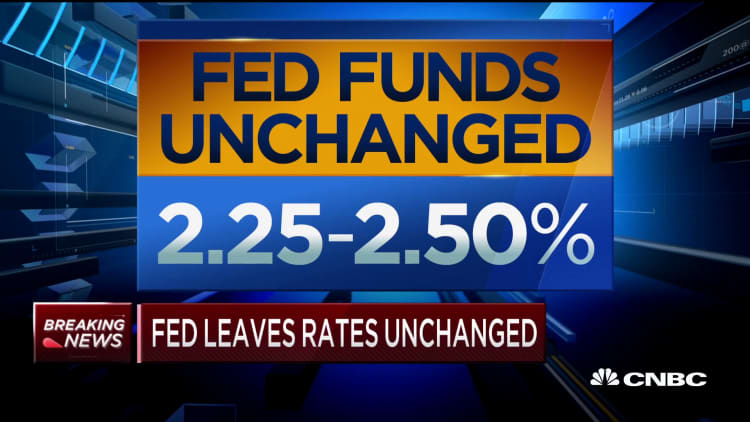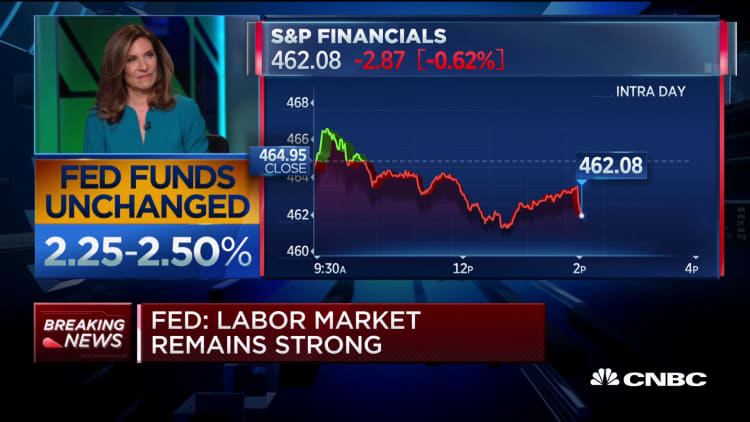Federal Reserve officials voted to hold interest rates steady Wednesday, as a lack of inflation pressure outweighed an economy that otherwise is growing strongly.
The central bank held its benchmark rate in a target between 2.25% and 2.5%, meeting market expectations though perhaps disappointing President Donald Trump, who earlier this week urged the Fed to cut the rate by 1 percentage point.
Trump has cited the lack of inflation as a key reason for a rate cut and said in two tweets Tuesday that economic growth would be much stronger if the Fed would ease the reins on policy.

Instead, the policymaking Federal Open Market Committee voted unanimously to hold the current range. The committee did, however, make a technical adjustment aimed at keeping the funds rate closer to the midpoint of the target range.
Interest paid on excess reserves that banks keep at the Fed will now be set at 2.35%, or 0.05 percentage points lower than before. Prior to two similar adjustments last year, the Fed had been raising the funds rate and reserves rate in tandem, with the latter acting as a cap for the benchmark rate.
However, the funds rate had been drifting to the top of its range, most recently trading at 2.45%. Banks currently are holding $1.56 trillion at the Fed, with all but $1.41 trillion considered excess.
In its view of the economy, the Fed tweaked some of the language from the statement after the March meeting to indicate that growth remains strong.
The statement this week said "economic activity rose at a solid rate" while again noting that job gains "have been solid" and that the unemployment rate "has remained low." The jobless rate is at 3.8%, around its lowest level in 50 years.
On the critical inflation question, the statement said "market-based measures of inflation compensation have remained low in recent months."
Running below 2%
The committee did offer another language tweak reflecting the lackluster inflation picture.
"On a 12-month basis, overall inflation and inflation for items other than food and energy have declined and are running below 2 percent," the statement said. After the March meeting, the committee chalked up the inflation weakness to lower energy prices.
The decision comes following a much stronger economic performance in the first quarter than virtually all economists had anticipated. GDP rose 3.2%, defying forecasts that had called for little if any growth.
Other than a weak February, the jobs market also has been strong. Economists project nonfarm payrolls in April grew by about 180,000; the report will be released Friday.

Financial markets also have been performing well, with the Dow Jones Industrial Average now up about 14% for 2019 after a disastrous close to 2018, brought on from market fears that the Fed would stay on a tightening path.
Inflation, though, has remained well below the Fed's 2% symmetric target. The central bank's preferred gauge showed just a 1.6% gain in March when excluding volatile food and energy prices.
Trump and other White House officials believe the low inflation opens the door for more easing. Markets, meanwhile, figure the Fed to hold steady for a while, then assign a 67% chance of a rate cut by the end of the year.
The Fed is easing up on policy a bit. Starting Thursday, the committee lowered the cap on the amount of Treasurys proceeds that will roll off the balance sheet reach month. Up to $30 billion had been allowed to roll, a level that will now decrease to $15 billion.
The Fed's balance sheet is currently just shy of $3.9 trillion, most of which is comprised of Treasurys and mortgage-backed securities. The MBS rolloff will hold at $20 billion a month.


